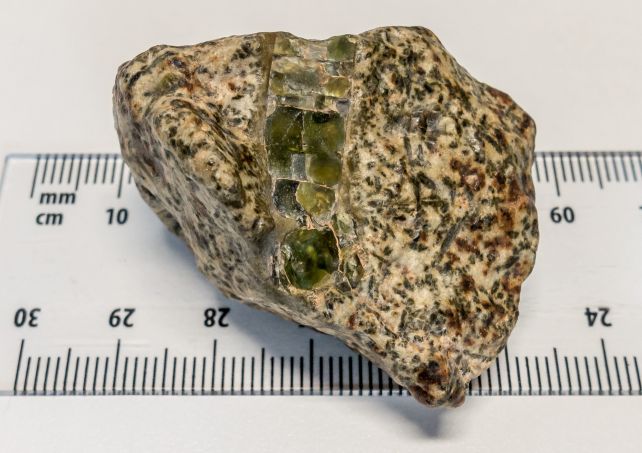 A piece of Erg Chech 002, showing a large piece of embedded pyroxene crystal. (Yuri Amelin)
A piece of Erg Chech 002, showing a large piece of embedded pyroxene crystal. (Yuri Amelin)
A piece of ancient space rock that ended up on Earth is giving scientists the clues they need to understand the cloud of dust from which the Solar System was born.
The rare object is known as Erg Chech 002, and an isotope contained within it suggests a sprinkling of radioactive material from recently exploded stars infused with our Solar System towards the end of its formation.
It's a fascinating glimpse into the solar environment billions of years ago, showing not just how meteorites can serve as time capsules preserving the secrets of the past, but that those secrets can then be used to better understand what we find in other space rocks.
The Sun, like all stars, was born from gas and dust. The solar nebula was a dense cloud floating in space, with a denser region that would collapse under gravity to form a baby star, spoiling in more and more material as it spun and grew. Once the Sun had swallowed its fill, the remaining disk of material went into forming the planets.

We have a rough idea what was in the nebula. After all, our own planet, and all the other planets and rocks and dust drifting through the Solar System were made from it.
But in many of those places, a lot has changed chemically over the 4.6 billion years or so since the Sun was a mere twinkle in a cloud of dust.
Meteorites and asteroids, by contrast, are thought to represent a relatively pristine sample of the Solar System at the time these objects formed, since they have remained more or less unchanged and unaltered since that time. So, we can study them to find out when they formed, and the composition of the material from which they did so.
This brings us back to Erg Chech 002, a meteorite older than Earth and unlike any other. Discovered in 2020 in the Erg Chech sand sea in southwestern Algeria, the stone has an unusual andesitic composition linked with igneous activity, suggesting that the object was once part of a planet early in formation, whose development was arrested early.
One of the elements it contains is a stable isotope of magnesium called magnesium-26. Magnesium-26 is a decay product from a particular radioactive isotope of aluminum, aluminum-26, that is produced during the violent supernova deaths of massive stars.










0 Comments